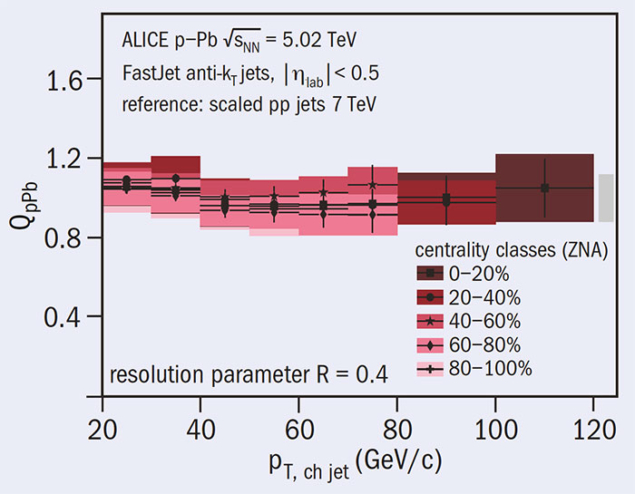
In the early stages of a high-energy collision, high-pT partons can be created, before producing sprays of hadrons that are measured experimentally as jets. Not only do high-pT partons carry information about the parton scattering itself, but they also serve as probes for the environment they cross. In nucleus–nucleus collisions, for instance, high-pT partons probe the strongly interacting medium of quarks and gluons (the quark-gluon plasma, QGP). Due to the interactions of these partons with the QGP, particle production is suppressed at large transverse momentum compared to an incoherent superposition of nucleon–nucleon collisions.

Image credit: ALICE Collaboration.
Although this observation is one of the key results in heavy-ion collisions, it is a priori not clear to which extent the suppression is caused by hot nuclear-matter effects, such as the jet-medium interaction, and to which extent by cold nuclear-matter effects, such as the presence of the nucleus itself. Unlike in lead–lead collisions, modifications of jet production due to hot nuclear-matter effects are not expected in proton–lead collisions. Therefore, measurements of the nuclear modification of jet spectra in proton–lead collisions can be used to disentangle cold from hot nuclear-matter effects.
ALICE has recently measured charged jet spectra and their nuclear modification in proton–lead collisions for transverse momenta within 20–120 GeV/c. The main corrections include the subtraction of a mean underlying event density and a statistical treatment of within-event fluctuations, as well as an unfolding of the detector response. One of the challenges in analysing proton–lead collisions is to be able to measure the collision geometry (called the event centrality), and also to evaluate the mean number of binary nucleon–nucleon collisions for different centralities. Several methods for centrality determination were tested in ALICE and the least-biased method was used for this measurement.
The measurement produces a clear result: for the probed acceptance, and within the systematic and statistical uncertainties, all nuclear modification factors are compatible with unity. The charged jet spectra measured in proton–lead collisions at an energy of 5.02 TeV do not show any significant centrality dependence and they scale with the jet spectra in proton–proton collisions at the same energy. Therefore, there is no evidence that high transverse momentum jets are modified by the cold nuclear medium, confirming the conclusion drawn from measurements of the nuclear modification factor for single high-transverse momentum hadrons.





